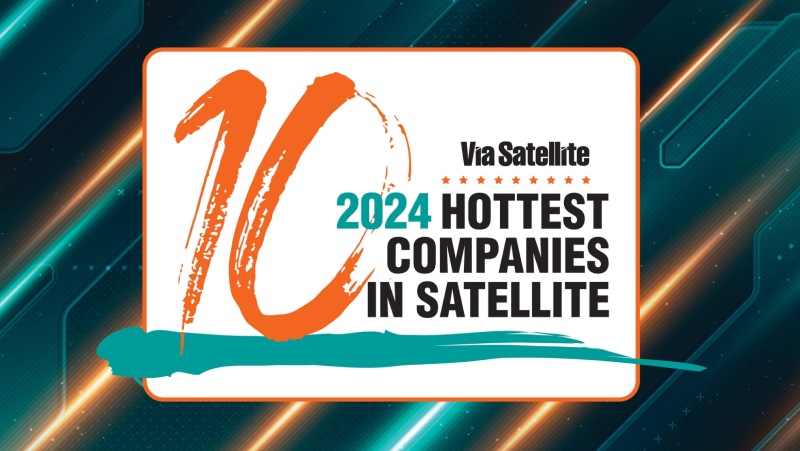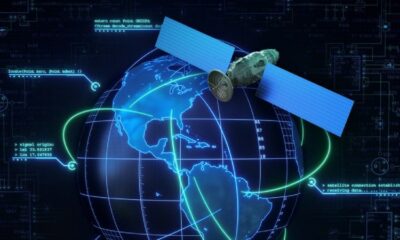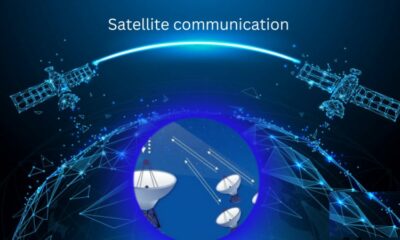Tech
Top 10 Hottest Satellite Companies of 2024

10 “must watch” companies in the satellite industry—from constellations, manufacturing, launch, and more—are compiled by Via Satellite’s 10 Hottest Companies. Based on a combination of factors such as market share, groundbreaking deals, revolutionary technology, and overall industry excitement, the editors of Via Satellite selected the companies on this list and anticipated activity for the coming year.
It’s amazing to watch new businesses join the list every year as the industry changes; this list is in its sixth year. When the list was first released in 2019, several of these businesses were nonexistent. Here, in alphabetical order, are the companies that were selected to be the Top 10 Hottest Satellite Companies of 2024:
- Amazon / Project Kuiper
Amazon will have to play catch up in the competition to launch its constellation of Low-Earth Orbit (LEO) satellite broadband satellites for at least the next few years. Unlike rivals who made the transition from paper to orbit, Amazon was able to launch its massive 3,236-satellite low-Earth orbit (LEO) system with greater time and runway thanks to its substantial financial resources. That time is running out as we begin the new year.
In 2024, things for Amazon get really real. To meet the rapidly approaching FCC deadline of launching at least half of its system within the next two years, the company plans to launch Kuiper in the first half of this year. Amazon will need a wide range of launch partners, including SpaceX, its primary rival, to meet this deadline.
This past December, during an optical inter-satellite link (OISL) test, Amazon’s prototype satellites maintained a stable connection speed of 100 gigabits per second, marking a significant technological milestone. Big satellite networks are linked together by OISL lasers to maintain synchronization. Systems like Kuiper and SpaceX’s Starlink, which were initially launched without inter-satellite links to expedite the orbital process, face particular challenges in this regard. According to Amazon’s OISL test results, once deployed, every satellite in the Kuiper system should be able to sustain connections.
This is a make-or-break time for Project Kuiper. With a strong base of software technology and a network of business partnerships, Amazon should have one of the most potent LEO satellite connectivity offerings ever seen in the market.
- Apex Space
Manufacturers are increasing their production to meet the growing demand from customers as more and more satellites are launched annually. Apex Space, a recent entrant, wants to reduce the manufacturing bus timeline to a matter of weeks or months. In October 2022, Los Angeles-based Apex—supported by venture capital firm Andreessen Horowitz—came out of stealth. Max Benassi and Ian Cinnamon, the company’s founders, are both veterans of startups: Benassi founded SpaceX and Astra, while Cinnamon worked at the AI startup Synapse.
The company does not specialize in custom engineering; instead, it focuses on standard products for quick manufacturing. With an emphasis on simplicity, it provides users with spacecraft user manuals and virtual flatsats that are simple to download from its website, enabling them to begin developing their plans. With plans to build a 600-kilogram ESPA-grande satellite bus platform, the company’s first model is the Aries spacecraft, a 100-kilogram bus that can support 100 kilograms of payload. Since its founding, Apex has expanded rapidly, and it intends to launch the first Aries bus on the next SpaceX Transporter-10 mission. To expand production, the company also signed a lease for a 4,300-square-meter factory in Los Angeles called Factory One. The company also raised a $16 million Series A round in June.
Apex is a company to watch in US manufacturing as it has set a bold goal to ramp up to 20 spacecraft by 2025.
- Impulse Space
The space industry took notice when Tom Mueller, a co-founder of SpaceX and the man behind the Merlin engine, launched his own propulsion business. As an in-space transportation company, Impulse Space claims to be able to deliver cargo to the Moon, Mars, Low-Earth Orbit, Geostationary Orbit, and beyond. Initially focusing on low-Earth orbit (LEO), the company moved swiftly to send its first spacecraft into orbit. After 15 months, the team completed the construction of the first Mira last-mile orbital transfer vehicle. All eight of Mira’s onboard thrusters were successfully fired after launch in November 2023, and the spacecraft is currently showcasing its capabilities in orbit.
The space industry took notice when Tom Mueller, the man behind the Merlin engine and a founding member of SpaceX, launched his own propulsion business. Offering in-space cargo transportation services to Low-Earth Orbit, Geostationary Orbit (GEO), the Moon, Mars, and other destinations, Impulse Space describes itself as a space transportation company. The business swiftly launched its first spacecraft into orbit after focusing first on low-Earth orbit. In less than 15 months, the team constructed the first Mira last-mile orbital transfer vehicle. Mira is currently showcasing its capabilities in orbit after successfully firing all eight of its onboard thrusters during its November 2023 launch.
Impulse Space, however, is planning to disrupt the launch market to GEO and beyond. The company recently unveiled Helios, a high-performance kick stage that can lift five tons from low Earth orbit (LEO) to geostationary orbit (GEO) in less than a day. This could spare satellite operators the months of pre-revenue orbit-raising time required to reach GEO using onboard propellant, potentially saving them tens of millions of dollars. Helios can send payloads to other solar system planets, Lagrange points, and sun and lunar orbits. In addition, the company has an agreement with Relativity Space to power the commercial space station Vast Haven-1 and a mission to Mars.
It’s reasonable to wonder how Mueller’s own business will revolutionize in-space logistics for the space economy given his pivotal role in the engine technology that transformed the launch industry over the last ten years.
- Rocket Factory Augsburg
Emerging companies like Rocket Factory Augsburg (RFA) are attempting to have an impact on the global space industry, demonstrating how vibrant the German space scene is even today. RFA was established in 2018 to provide weekly launch services for up to 1,300 kilograms into low-Earth orbit (LEO) and beyond.
As the first private company in Europe to successfully hot fire a stage with a staged-combustion engine for its entire duration, the company accomplished a full hot fire engine test in June of last year. Additionally, the UK Space Agency (UKSA) awarded the company funding in late 2017 totaling 3.5 million pounds ($4.45 million) to support their launch plans from SaxaVord Spaceport in the Shetland Islands. The money will be used by RFA UK to build and run the testing apparatus and infrastructure required to launch the RFA ONE launch system from SaxaVord Spaceport. The German Aerospace Center (DLR) has fully reserved both of its test flights, with the first one scheduled for this summer from Shetland.
If the launch is successful, it will be a significant win for Germany, the United Kingdom, and Europe as a whole, as well as for RFA—especially in light of the unsuccessful Virgin Orbit mission from Cornwall last year. Europe is looking forward to more successful launches from British soil. Perhaps this is the year that European commercial launching really takes off.
- Skylo
Skylo has adopted an interesting strategy in the direct-to-device space as the worlds of satellite and cellular technology merge, utilizing current satellites and spectrum to develop a software solution for direct-to-device connectivity. To certify their devices on Skylo’s network and enable satellite-based connectivity without the need for hardware updates, the company collaborates with international chipset manufacturers and module makers. When outside of cellular coverage, compatible devices can “roam” onto Skylo’s network because narrowband connectivity is provided by partner satellites from Ligado and Viasat.
Working with a long list of top chip manufacturers, module makers, and MNOs, such as Samsung, Qualcomm, Quectel, Soracom, and Keysight, the company boasts an impressive ecosystem of partners. Given that Skylo opted to concentrate on its own technology stack and collaborate with already-existing satellites rather than launching its own satellites, the decision to work with Viasat is an intriguing one.
For MNOs and device manufacturers, Skylo’s solution is easy to implement and can be used for a variety of use cases, including mass-market consumer devices, automotive, IoT, and more. Furthermore, Skylo is not a vendor lock or proprietary solution because it has opted to operate within 3GPP Release-17 standards. With the recent $37 million funding round, the company added new investors. MNOs currently have a variety of options when it comes to their satellite partners, and it will be interesting to watch how Skylo expands with its extensive network of alliances.
- Space42
Yahsat, the satellite operator in the United Arab Emirates, and Bayanat, the provider of AI-powered geospatial solutions, announced plans to merge at the end of 2023 to form SPACE42, a brand-new AI-powered space technology powerhouse. This piece of industry consolidation is very different. It unites a satellite operator and a provider of geospatial solutions, rather than two satellite operators or two geospatial businesses. Karim Michel Sabbagh, the former CEO of SES, has been named SPACE42’s managing director designate, which seems like a somewhat unexpected appointment. The planned merger of Bayanat and Yahsat, pending approval and anticipated to be finalized in mid-2024, serves as the foundation for the business.
Launched just under two decades ago, Yahsat has been a tremendous success story. Today, the company is leading the fusion of traditional GEO, AI, and geospatial in a way that could usher in a new era of combined space services. The goal, according to Sabbagh, is to establish “a unique, vertically integrated provider of AI-powered geospatial and mobility solutions, earth observation, satellite communications, IoT and business intelligence,” in one of his first interviews following his appointment. The proposed business is beset with numerous issues. Is it able to break into new markets and secure exclusive business? Can SPACE42 demonstrate innovative new features that highlight satellite operator and legacy AI technology? When it comes to combining the capabilities of AI and space, SPACE42 has the potential to have a significant impact on the space industry.
- SWISSto12
SWISSto12 has progressed from being a component specialist to a full-fledged satellite manufacturer since making one of its earliest appearances at the SATELLITE conference’s inaugural Startup Space competition back in 2016. The company’s name alludes to the reputation of its home Switzerland for superb clock and watch design, as well as the development of small, affordable geostationary satellites.
Selling its GEO smallsat HummingSat platform, SWISSto12 has had great success. HummingSat is a satellite platform that carries sophisticated radio frequency payloads in a form factor that is ten times lighter and less expensive than most legacy GEO satellite models. It is funded by the European Space Agency (ESA) Ministerial Council. Launches of HummingSat models are planned for the next two years on Intelsat and Inmarsat (which is now owned by Viasat).
Similar to other manufacturing startups that have persevered through numerous funding rounds, SWISSto12 is striving to establish its footprint throughout the whole satellite supply chain. The company is working with Thales Alenia Space to develop Ka-band solid-state power amplifiers (SSPAs), which will act as an antenna link between Earth and the HummingSat series of satellites. According to Emile de Rijk, founder and CEO of SWISSto12, the business is “proud to be at the core of Europe’s new space ecosystem.” It’s a highly calculated statement, given that the momentum of Europe’s international space industry is being restored by startups such as SWISSto12, whose success is becoming more and more dependent upon them.
- Telesat
Many doubts existed regarding Telesat at the beginning of 2023. Would Lightspeed even be built given the fierce competition and delays in its completion? When Telesat revealed in August of last year that it had secured funding to expand its constellation with 198 satellites, we finally had our answer. Additionally, the operator moved to MDA as the manufacturer from Thales Alenia Space. Modern technology will be included in the constellation, including optical inter-satellite links, onboard data processing, and phased array antennas.
The CEO of Telesat, Dan Goldberg, stated to Via Satellite in a short interview that Lightspeed’s advancement was “hugely energizing and positive” due to the funding and agreement with MDA, as well as the outreach Telesat was receiving from other industry players. Telesat went from a waiting to an execution mode after the announcement.
When it comes to several of its competitors, including Eutelsat, SES, and Intelsat, Telesat has adopted a somewhat different strategy. Investing in its own constellation is Telesat’s natural course of action. Comparing those operators—all of which have had CEO changes recently, despite Goldberg’s continued leadership of Telesat—is also fascinating. Telesat is back in the game, but there are still obstacles to overcome. The business is now moving forward and full of enthusiasm as it attempts to fulfill its lofty LEO goals.
- True Anomaly
The challenges of security, readiness, and space domain awareness are the main focus of True Anomaly. The company offers two products: Jackal, an autonomous orbital vehicle (AOV) intended for real-time and simulated space rendezvous and proximity operations, and Mosaic, an integrated software platform intended to provide space domain awareness and security services. Together, Mosaic and Jackal may offer clients a potent toolkit for space security. In this instance, the most dependable insurance plan for long-term space interests is being marketed as AI-powered technology in a market that is expanding quickly.
The company is employing former government executives to secure long-term government investment, following a tried-and-true path to success in the cutthroat space security market. True Anomaly is on track to start showcasing its capabilities in mid-2024, having obtained a license from the National Oceanic and Atmospheric Administration (NOAA) to operate its first two Jackal AOVs, which are scheduled to launch no earlier than March 1. That is incredibly quick for a startup.
True Anomaly spent the previous year engaging in all the exciting activities that space startups enjoy. They raised a significant amount of capital, came out of stealth mode, and constructed an amazing 35,000-square-foot manufacturing facility. They also had an ambitious mission statement. The difficult part is about to come in 2024: proving the business model. The success of True Anomaly’s business strategy depends on how well-received its innovative hybrid hardware/software offering is by consumers. True Anomaly has the potential to surprise many established space companies if it can deliver on its promises of producing a fully-tested satellite every five days and live up to the hype.
- Xona Space Systems
GPS and other satellite navigation systems are essential to much of the global economy. Although this technology has historically been used by governments, startups have recently shaken up the market by offering substitute systems. Among the businesses aiming to develop the next wave of satellite navigation is Xona Space Systems. A constellation of tiny low-Earth orbit (LEO) satellites powers Xona Pulsar, a commercial satellite navigation service that gives customers high-performance positioning, navigation, and timing (PNT).
It declared last year that it was working with the U.S. Space Force and the Air Force Research Laboratory (AFRL) to develop a secure LEO PNT architecture that would make use of Xona’s Pulsar service, a significant validation of its technology. Lockheed Martin, which provides support to the company, recently declared that they will work together to safeguard Xona’s Pulsar services using military-grade security procedures.
With its small satellite technology, Xona hopes to give users a reliable and safe substitute for GNSS from satellites that are 25 times closer to Earth. It thinks that with more than ten times the accuracy of GNSS, its Pulsar service can offer a worldwide service at a reasonable price. With its high-performance satellite navigation services, it hopes to penetrate several markets, including critical infrastructure, maritime, agricultural, IoT, weather, and aerial mobility. It will be interesting to observe how Xona Space Systems, one of the pioneers in the commercial GNSS alternatives space, impacts the satellite navigation industry.
-

 Travel4 weeks ago
Travel4 weeks agoBwindi’s Gorilla Tourism: Saving Wildlife, Empowering Communities
-

 Education4 weeks ago
Education4 weeks agoJoseph Curran: Using Legal Writing and Advocacy to Simplify Complex Issues for Clients
-

 Tech4 weeks ago
Tech4 weeks agoGoogle Offers New Travel-related Features To Search And Launches Its AI “Flight Deals” Tool Around The World
-

 Business4 weeks ago
Business4 weeks agoStop the Bleeding: How Unanswered Comments Increase Your CAC
-

 Cryptocurrency2 weeks ago
Cryptocurrency2 weeks agoRami Beracha Asks, Can Israel Become A Global Leader In Blockchain Innovation?
-

 Tech3 weeks ago
Tech3 weeks agoAdsPower Promo Code for 50% Off – Ultimate Guide to AdsPower Benefits (Referral Code Included)
-

 Education2 weeks ago
Education2 weeks agoForged in Fire: Nicholas Lawless Unveils Lawless Leadership – The Model Built for a World That Traditional Leadership Can’t Survive
-

 Business2 weeks ago
Business2 weeks agoOPO Group LTD Strengthens Its Global Footprint With Expanding Offices and a Modernized Trading Ecosystem
















